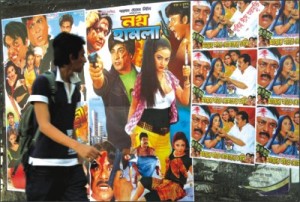 The cinema industry seems to best resemble its oldest cinema hall, the Picture House, later known as Shabistan, which was established in Armanitola of Old Dhaka in 1913.
The cinema industry seems to best resemble its oldest cinema hall, the Picture House, later known as Shabistan, which was established in Armanitola of Old Dhaka in 1913.
The place where the cinema hall had once stood with pride and dignity for over 90 years is now a quiet area with eight to nine residential buildings, standing face to face, with an ailing passage that fades after a few yards.
At the end of the road stands a wall with a signboard of Islahul Ummah Madrasa and School that is located in one of those buildings. Nothing in the area carries the mark of the long-standing cinema projection house, except for in the minds of people.
“I always felt passionate about watching a movie at Shabistan as I knew that it was the oldest cinema hall in the country,” said Rafiqual Islam, an Old Dhaka resident.
“The last cinema I watched there was The Mummy Returns but soon afterwards, I learnt that the hall was being replaced by buildings.”
The tale of Shabistan is the same as hundreds of other cinema halls around the country, which were shut for being in the red for prolonged periods.
Hall owners blame thinning audiences for the losses, which led a number of cinema halls to pull down the shutters in the past few years.
“Around 10 years ago, we received around 600 to 800 people per show. But now, one show attracts only 200 viewers,” says Paresh Chandra Ghosh, an accountant of Purabi Cinema Hall in Mirpur.
He said good films still pull in large audiences, but such films are rarely produced.
Sector people and cinema critics said it was the low quality of cinemas, an absence of creativity, a stagnant market and sheer government negligence that almost guillotined the industry. It is the only available source of recreation for a chunk of people in the country, mainly for the low and middle classes.
In recent years, the poor turnout has also affected the production of cinemas by the Bangladesh Film Development Corporation (BFDC), popularly known as Dhaliwood, which was established in 1957.
In 2009, 41 films were produced in Dhaka — until February. The industry saw 74 films in 2008 and 84 in 2007, according to BFDC statistics.
The notion is that the satellite culture, obscenity and piracy have made investment in the industry highly vulnerable.
“If I invest Tk 1 crore on a film, I will not be at ease because it could be stolen. Pirated CDs and VCDs of the film could be distributed overnight across the country,” cinema producer Ustad Jahangir Alam told The Daily Star. He has been trying to put an end to piracy for long.
But cinema critic Dr Gitiara Nasreen has a different view. “It would have been a blessing for us if a cinema produced in Dhaka had been so popular that it was worth being pirated,” she said.
Nasreen also rejected the view that an availability of satellite channels has largely reduced the appeal for cinemas.
Putting forward an argument, Nasreen, who teaches in the department of Mass Communication and Journalism at Dhaka University, said, “Nowadays every sports match is aired on television, but still people battle to buy tickets to watch the match at the stadium.”
“Similarly, satellite channels are very popular in the US and simultaneously, cinema halls also do good business over there.”
She said cinema halls have a different appeal and people would definitely go there if films were entertaining.
The sector people said skilled filmmakers were left with no other option but to quit because of a low level of government support and poor infrastructure and technology. This left a vacuum that was later filled with people who had low filmmaking skills.
These people latter increased violence and obscenity in films to attract audience and the film industry suffered as a result.
They believe coordinated government efforts, including bank facilities and good film institutes, are required to pick the industry from shambles and make it profitable and competitive.
Filmmaker Tareq Masud said: “Bangladeshi cinemas were at its peak in the 1960s, when it competed with films made in Bombay, Hollywood and in Urdu. Viewer turnout was also impressive then.”
“Bangladeshi cinemas were doing well at that time and the famous Uttam-Suchitra pair was highly acclaimed among Bangalee cinema viewers,” said Masud.
He said the government should allow private investment in BFDC to set up new studios and modern equipment as the present infrastructure is in a shabby state.
He suggested the government should privatise BFDC or relax government control, just like Bangladesh Telecom Company Limited and Biman.
“In the 1960s, the film industry was among the top industries, boasting huge revenue generation,” said Masud. He urged the government to provide loans for high quality film production, which is followed in many countries, including India.
If a conservative country like Iran could receive global acclaim through the film industry, why not Bangladesh,” questioned Masud, urging a bold government policy.
Emdad Hossain, acting managing director of BFDC, identified satellite channels, obsolete technology and obscenity as the main reasons behind the present state of the cinema industry.
But he is optimistic about the future of the film industry. The government has recently undertaken a project to modernise it, he said.

